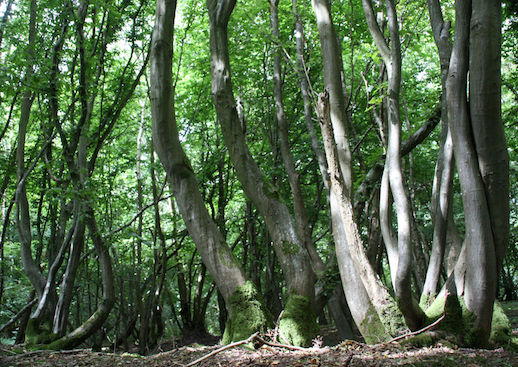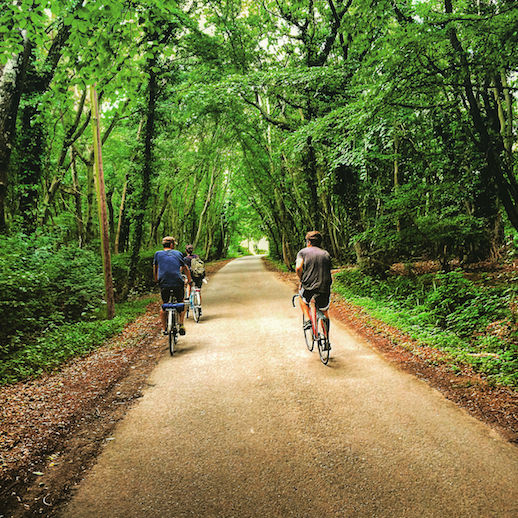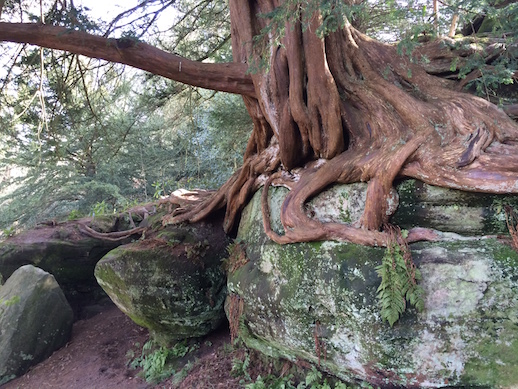 Old coppice, by Andreas Groeger
Old coppice, by Andreas Groeger
Words: Katherine Price
In August, I received my first Christmas catalogue through the post. Goodbye RHS, that’s the last straw. Don’t try to rob me of the precious weeks ahead.
These last few nights I have been woken by the thump of the neighbour’s apples falling on the garden fence. I keep walking face first into the webs that fat nervous spiders have strung between the shrubs. The spiky teasels’ heads catapult their seed across the veg patch with the slightest twitch, the blackberries and elderberries have grown glossy and plump with the recent rain, the sloes are as blue as the afternoon sky, and the second crop of figs is swelling in spite of the nip in the morning air.
In recent days, starlings have displaced the pigeons on the Victorian cupolas of the primary school across the road. They are all bells and whistles, launching in mass forays, settling briefly, swapping places. Something’s up.
Autumn. But the year isn’t over, not by a long shot. There’s energy about the place, thrilling change after the languid decay of summer. If I were a hop-picker I would just be setting off to Kent with the hordes. If I were a shepherd, I’d be bringing the finished wether lambs off the hills and looking to sell. If I were a ring master, I’d be marking up Twickenham Green with white pegs and orange netting for the first stop on the circus’s autumn tour. And if I were a swineherd, I’d be going into the woods.
This seasonal movement of pigs is an ancient thing. In late summer the animals are driven into the forest to feed on its fruits – acorns beechmast, chestnuts, hazelnuts. So important was pannage to the local economy at certain points in history that it was used as a measure – the land’s value counted by the number of swine it could support.
 Cycling in the High Weald, by Eleanor Massey
Cycling in the High Weald, by Eleanor Massey
If you turn your back on the big skies and flocks of lapwings over Romney Marsh and cycle north-west into the High Weald, you follow roads and pass through settlements that were shaped by this annual movement of people and stock. Rich land it may have been, but the dramatic topography defied wholesale clearance (and still keeps the cyclists away) and the Weald – from the old English ‘Wald’ or wood – is even now one of the most densely forested places in Europe.
The Wealden landform that straddles east Sussex and west Kent is the yolk to the white of the North and South Downs. In the age of dinosaurs, flood-plains and rivers laid down layers of iron-rich clays and sandstones. 110 million years ago, in the middle of the Cretaceous period, these sediments sunk beneath the sea. The carcasses of billions of sea creatures deposited a thick layer of chalk on the sea floor. When the African continent crashed into Europe, forming the Alps, ripples from the collision spread northwards and a huge chalk dome – the Wealden anticline – rose in what is now southeast England. Over millennia the chalk dome eroded and, like the top of the boiled egg being taken off, unearthed the sandstone and clay strata. In their turn, sandwiched between the Downs, the exposed clays eroded faster than the sandstone, creating cliffs and steep-sided valleys, known locally as ‘gills’. Like the yolk, the sandstone and clay is richer, sustaining magnificent broadleaved woods of oak and beech and ash.
The ravines and ridges mean that the High Weald was unsuitable for large-scale agriculture, so it was not settled in the same way as the surrounding land. Instead, the forest was managed to support the iron industry and swine. Pigs were driven up the ancient lanes to seasonal wood-pasture or ‘dens’ – the nucleii of present day villages, Tenterden, Rolvenden, Newenden, Benenden. Many of these lanes or ‘droves’ survive as the roads we use now. Iron ore was plentiful and easily accessible through open cast mines that were worked even in prehistoric times. The Romans had interests in the iron industry too and it saw a resurgence in medieval times. The woods are pockmarked with the remains of furnace or hammer ponds, dark and glassy at the end of summer when the newts and toads have quit their breeding waters. Iron was extracted by ‘smelting’, a process that needs high-quality charcoal to produce sufficient heat. Way before the Romans, people were coppicing hornbeam, chestnut and hazel to produce a harvest of wood to make charcoal. Coppicing maintained floral diversity, bringing light to the forest floor every few years, regenerating the primrose and violet colonies, providing home for the dormouse and glades for the pearl bordered fritillaries.
I’ve often thought of broadleaved woodland as the fifth element, somewhere between air and water. Early autumn reinforces this idea. Lay up your bike in summer’s debris by the road, in the crisp seed heads of yellow rattle and smashed stalks of cow parsley. Push through the meniscus of bramble, wood sage and willow herb, leaving behind the butterflies and bees that linger in the still hot sun. Pass the rheumatoid knuckles of coppiced hornbeam boles and give yourself up to sensory assault of the woodland cavity. Limpid air, cool and humid as a teenager’s breath, filtered light and mouldering leaves. By now the forest floor has been in shade for months and little remains of the herbs that exploded into flower before the leaf canopy closed. The only green comes from the bitter ferns with their rusty spores – hart’s tongue, polypody, buckler. Sound travels differently here and morphs to the rhythmic variations of coppice, plantation, shaw, old growth. Now and then the mew of a buzzard, great tits scolding their demanding fledglings, the thin high chatter of goldcrests in the yew and Scots pine, but in between a deep, round silence broken only by the crack of twigs underfoot and pop and gurgle of the runnels carving through mossy banks. Follow the flow and the oak gives way to alder, birch and willow on the wetter ground, where sedges and buckthorn colonise the bogs and pipistrelles fly at dusk. Go against the flow, up the steep side of the valley and you may encounter one of the Weald’s treasures, the sandstone outcrop.The combination of the dense tree canopy and the blocky sandrock that holds onto the rain creates a humid micro climate, more like the oceanic climate of the western extremes of Europe. Here grow mosses, liverworts and filmy ferns, the enigmatic plant life collectively known as cryptograms.
The Weald, early autumn. Pigs are no longer driven up here. Beneath the trees, it’s calm. Despite successive assaults from larvae and insects, the canopy has remained intact and the recent rain has not reached the forest floor, crummy and strewn with mast. The ground itself has yet to receive its annual mulch of fallen leaves that will slowly return to the soil, broken down by the writhing seam of micro fauna and flora at the surface of the centuries-old soils.
This is the quiet time, before the autumn storms start, before the fall of leaves begins – first ash, then beech and latest oak. It will be some months before the birds begin their territorial song. The brittle roots of wood anemone, the pale long bulbs of garlic and bluebell lie dormant in their arid beds, waiting for spring.
And in this quiet time you sense the latent power of the land, its hidden wealth. Rising out of the sandstone, countless small, fast flowing streams feed the rivers that splay out of the Weald. The Rother, Tillingham and Brede (formerly the Ee) flowing south east to Romney Marsh; below the main ridge, the Adur, Ouse, and Cuckmere flow due south to the Sussex coast; rising in the north, the headwaters of the Medway and its tributary, the Eden, while the Bewl and the Teise flow into the Medway further downstream. Their waters have carved valleys that give space to rich habitats where voles, otters and crayfish thrive and fish spawn. They feed the declining water meadows where snipe and lapwing breed and some migrant species spend their winters.
 Yew on sandstone, by Katherine Price
Yew on sandstone, by Katherine Price
High up on a Wealden ridge, where the old yew clings to the sandstone outcrop with its sinuous roots, you are alone in the silent woods and yet utterly connected to the teeming wild around you, like the fat nervous spider at the centre of its web, exposed, alive to the smallest vibration at the edge of things.
Katherine will be hosting Caught by the River contributors Melissa Harrison and Rob Cowen at Kew’s first LitFest this Saturday, 26 September. More info here
Follow Katherine’s Twitter here